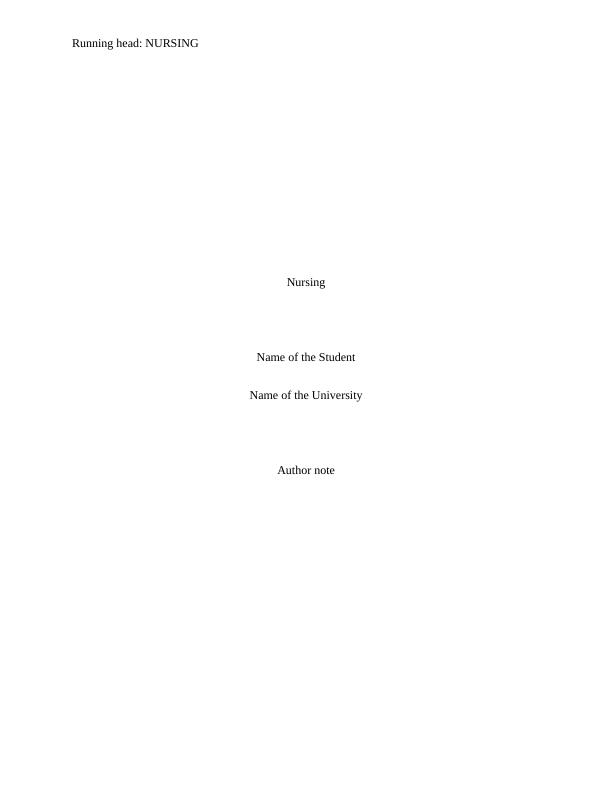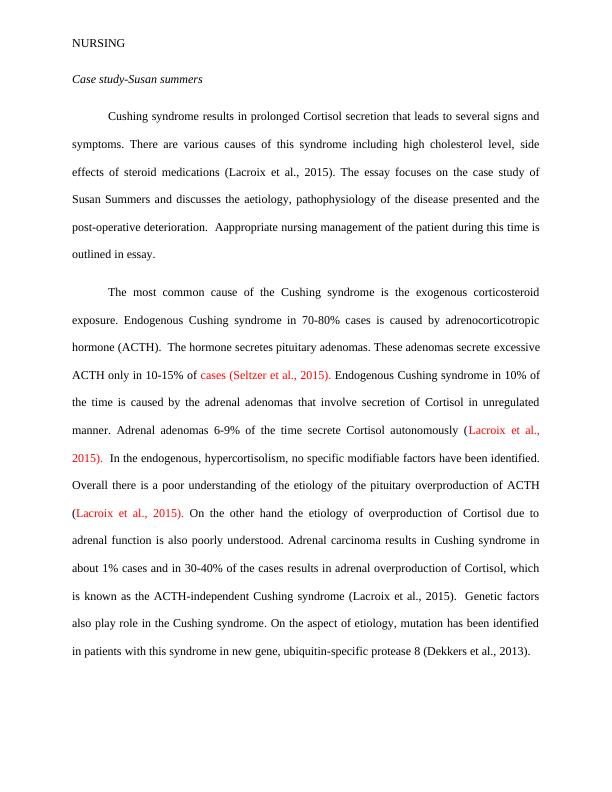Cushing syndrome - Symptoms and causes
Added on 2021-04-21
11 Pages3010 Words46 Views
Running head: NURSING Nursing Name of the StudentName of the UniversityAuthor note

NURSINGCase study-Susan summers Cushing syndrome results in prolonged Cortisol secretion that leads to several signs andsymptoms. There are various causes of this syndrome including high cholesterol level, sideeffects of steroid medications (Lacroix et al., 2015). The essay focuses on the case study ofSusan Summers and discusses the aetiology, pathophysiology of the disease presented and thepost-operative deterioration. Aappropriate nursing management of the patient during this time isoutlined in essay. The most common cause of the Cushing syndrome is the exogenous corticosteroidexposure. Endogenous Cushing syndrome in 70-80% cases is caused by adrenocorticotropichormone (ACTH). The hormone secretes pituitary adenomas. These adenomas secreteexcessiveACTH only in 10-15% of cases (Seltzer et al., 2015). Endogenous Cushing syndrome in 10% ofthe time is caused by the adrenal adenomas that involve secretion of Cortisol in unregulatedmanner. Adrenal adenomas 6-9% of the time secrete Cortisol autonomously (Lacroix et al.,2015). In the endogenous, hypercortisolism, no specific modifiable factors have been identified.Overall there is a poor understanding of the etiology of the pituitary overproduction of ACTH(Lacroix et al., 2015). On the other hand the etiology of overproduction of Cortisol due toadrenal function is also poorly understood. Adrenal carcinoma results in Cushing syndrome inabout 1% cases and in 30-40% of the cases results in adrenal overproduction of Cortisol, whichis known as the ACTH-independent Cushing syndrome (Lacroix et al., 2015). Genetic factorsalso play role in the Cushing syndrome. On the aspect of etiology, mutation has been identifiedin patients with this syndrome in new gene, ubiquitin-specific protease 8 (Dekkers et al., 2013).

NURSINGThe literature on aetiology shows that, the patient’s presenting Cushing syndrome can bedue to the endogenous glucocorticoid overproduction. Cushing syndrome is manifested due toACTH independenthypercortisolism. It is primarily due to adrenocortical neoplasmthat isadenoma as commonly known. It is rarely called as carcinoma (Lacroix et al., 2015). In thisdisease there is an excess secretion of Cortisol. In ACTH independenthypercortisolism, the levelof ACTH is low due to negative feedback. It occurs from high serum Cortisol level that givesnegative feedback to pituitary corticotroph cells (Lacroix et al., 2015). In Cushing syndrome thatis ACTH dependent the level of ACTH is high that stimulates the adrenal gland to secrete excessCortisol. It is attributed to the anterior pituitary tumor. However, Cushing syndrome is alsocaused by the Nonpituitary ectopic sources of ACTH (Lacroix et al., 2015). It includesneuroendocrine tumors, resulting in the high ACTH levels. Eventually it results in thehypercortisolism (Prodam et al., 2013). It is manifested in the form of severe muscle weaknessand weight loss. The clinical manifestation results from excess exposure of the tissues to theCortisol. It is the case of Susan Summers, who is diagnosed with Cushing syndrome due tobenign tumour of her right adrenal gland. It is also called as adrenal adenomas (Nieman, 2015).It is the reason for excess production of Cortisol in the patient as adrenal gland comprises ofCortisol producing cells. The patient is suffering from ACTH independent Cushing syndrome. The symptoms associated with the disease are the obesity, diabetes, hypertension,weakness, moon face, menstrual abnormalities, excess hair growth and problems in bones(Pivonello et al., 2016). Two of the above symptoms noted in the patient given in case study areobesity and type 2 diabetes. Excess secretion of Cortisol results in high blood glucose level andcauses weight gain. Patients with this syndrome in 60-70% of the cases have been found to haveimpaired glucose tolerance. It results in diabetes eventually and specifically type 2 diabetes if

NURSINGthere is an insulin resistance and obesity (Karaman et al., 2017). When glucose tolerance isimpaired, the beta cells of pancreas are unable to increase the insulin secretion to compensate forthe insulin resistance (Elliott & Coventry, 2012). Body cells like muscles, liver, and fat cells failto respond to insulin. Liver cells fail to store glycogen, triglycerides are broken to fatty acids forenergy in fat cells and muscle cells are deprived of energy (Pivonello et al., 2016). It increasesthe glucose level. People like Susan with type 2 diabetes have high likelihood of developingCushing syndrome. Obesity is caused by increase weight gain and fat level. Cortisol alters the metabolism ofcarbohydrates, proteins, and fats when secreted in excess level. It is the chief stress hormone ofthe body and helps reduce inflammation (Polak et al., 2016). Excess Cortisol increases theappetitite and therefore enhances fat synthesis and accumulation. It results in weight gain andobesity (Bizarro et al., 2015). On the other hand active Cortisol is also produced by the Adiposestromal cells. These cells are not from subcutaneous fat but from the omental fat. This Cortisol isproduced from the inactive cortisone via expression of enzyme 11β-HSD1. This enzyme hasincreased expression after exposure to Cortisol. Thus, glucocorticoids are constantly exposed tothe omental adipose tissues (Rodriguez et al., 2015). Excess glucorticoids stimulatesgluconeogenesis in the liver. They increase glucose production and inhibit the insulin sensitivity.It is eventually manifested as diabetes (Bizarro et al., 2015). Postoperative patient are regularly assessed to rule out any abnormality andcomplications, as they commonly occur after surgery (Brown et al., 2017). It includesmeasurement of vital signs and general physical condition. The blood pressure in normalcondition should be 120/80 mmHg, whereas the patient showed higher than the range (160/90mm Hg) indicating high blood pressure and hypertensiveness. A high pulse rate was observed in

End of preview
Want to access all the pages? Upload your documents or become a member.
Related Documents
Adrenalectomy Pathophysiology and Nursing Carelg...
|9
|2558
|61
NRSG258 Acute Care Nursing : Assignmentlg...
|10
|2874
|30
Cushing Syndrome: A Clinical Case Study on SuSANlg...
|8
|2389
|317
KIN 4043 - Therapeutic Case Studylg...
|12
|4547
|42
Assignment on Cushing's Syndromelg...
|9
|2447
|46
Cushing's Syndrome: Causes, Symptoms, Treatment and Nursing Care Strategieslg...
|10
|2776
|279
